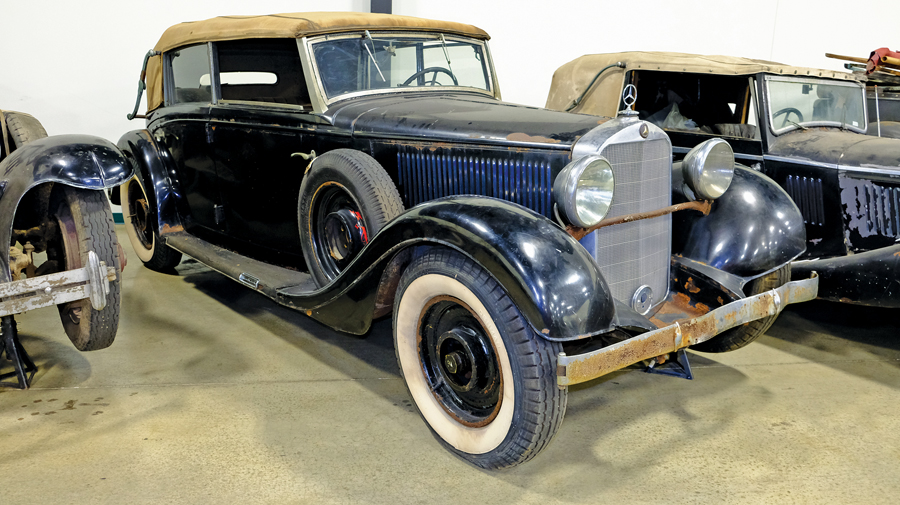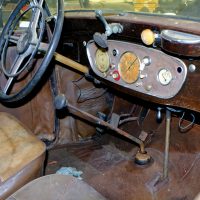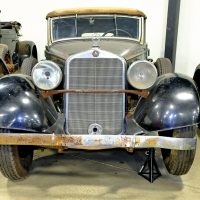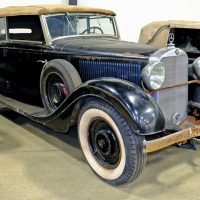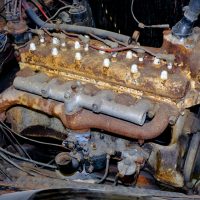SCM Analysis
Detailing
| Vehicle: | 1934 Mercedes-Benz 290 Cabriolet D |
| Years Produced: | 1933–37 |
| Number Produced: | 7,405 |
| Original List Price: | 9,500 marks ($69,400 today) |
| SCM Valuation: | $203,929 |
| Distributor Caps: | Whatever the seller wants |
| Chassis Number Location: | On firewall bulkhead |
| Engine Number Location: | Left rear section of engine block on crankcase |
| Club Info: | Mercedes-Benz Veterans Club of Germany |
| Website: | http://www.MVConline.de |
| Alternatives: | 1935–40 Maybach SW35, 1937–41 BMW 327, 1934–36 Adler Trumpf |
| Investment Grade: | B |
This car, Lot 461, sold for $117,600, including buyer’s premium, at Bonhams’ Tupelo Automobile Museum Sale in Tupelo, MS, on April 27, 2019.
Having been present at this auction, I stopped short when the gavel came down at what I felt was an incredibly strong price for such an obscure car in such neglected condition.
If you ask most Americans, there were two types of road-going Mercedes in the 1930s — the supercharged 8-cylinder cars (500K and 540K) and the “other” Mercedes Benz models, most of which are unknown to us.
Obscure Mercedes from the Depression
Imagine it is a 1934 summer Saturday in Germany. You decide to take the family on a picnic in the countryside, so you hop into your new car.
You are not a baron or a wealthy captain of industry, but you have managed to navigate the past 10 years with your finances intact. Recently you have purchased Mercedes’ new midsize model, the W18 290. While neither fast nor sporty, this solidly built vehicle should provide reliable transportation to and from work and on weekend outings and holidays.
At the time, you could have also purchased a Mercedes W21 type 200, with a small 6-cylinder engine, or the big W08 500 model if you needed more power.
Now, imagine it is just before the start of World War II. If you still like Mercedes, chances are you will be driving a W136 170 or the W143 Type 230. While the W136 attained an enduring reputation as the Mercedes that survived the war and brought the company back to post-war stability, history has not been kind to these other models.
At least in the eyes of most Americans, they live in the shadows of the 500K, 540K and 770K.
A little-known transatlantic market
Yes, this car sold for a strong price. However, if you think that the obscurity of this car translates to global worthlessness, think again.
This is still the kind of car you would want to take on a summer weekend picnic — if you are one of the many European pre-war Mercedes enthusiasts. This W18 and the other cars previously mentioned have a dedicated — but somewhat private — following in the European Union.
All of these models, just like the 500 and 540K, were built as Cabriolet As, Bs, Cs and Ds. The A was (usually) an elegant 2-passenger version, while the B version of any Mercedes cabriolet has a squared-off back and a rear seat. Cabriolet C versions were similar to a Cabriolet B, but with less room behind the front seats, and D versions had four doors, just like our subject car.
A rare and elegant special roadster was also built.
These cars occupy the market in the $100k–$700k range of pre-war Mercedes, right below the big supercharged cars. Although infrequently discussed, they usually bring consistent results in the aforementioned price range.
Destined to be dealer inventory
The winning bidder of this car was none other than Peter Kumar’s Gullwing Motor Cars in Astoria, NY. Gullwing aggressively buys Number 5 or Number 6 condition classic European cars, and you can’t spend five minutes on Hemmings without seeing their ads.
One week after the sale, this 290 was listed on their website for $167,500. If you somehow feel you missed your chance, an extra $50k will turn back the hands of time. They did not even bother to air up the tires or wipe off the dust.
Many of Gullwing’s clients are European brokers who fill up a container, ship several major projects to the EU, restore and sell the best ones, and peddle the worst ones to other restoration shops.
European buyers simply assume the car needs everything, and they often sub out labor to less-expensive shops in Eastern Europe or the Baltic states. This highly sustainable business model has put many wonderful cars back on the road, but few Americans seem to be aware of it.
The classic-car museum problem
Close inspection of the European cars at the Tupelo Automobile Museum revealed that most were in derelict condition, often with cheap resprays in weird colors. The most lamentable of these was a 1967 Mercedes 300SEL, one of 2,200 built, originally black and resprayed in an awful pea green shade.
However, our subject 290 Cabriolet D managed to evade this sort of treatment, likely because knowing where to start, where to get parts and how to execute the restoration was such a challenge.
With meager parts resources, a stuck engine, rusty frame and plenty of electrical issues, this car was a problem no one attempted to solve. Other than it being complete — and not having a huge amount of rot — this car needed absolutely everything.
Even the engine block looked like it had been submerged in brine.
Strangely, several bidders were drawn to this obscure Mercedes, but most cars in the back room of the museum did not attract as much attention.
Back to the beginning
Our subject Mercedes still has not completed its cycle, the cycle of returning to its home country, finding a new owner, receiving a costly restoration — and motoring on sunny days for picnics in the country.
Along the way, machinists will have to make pistons, metal workers will have to fabricate bespoke chrome parts, welders will have to re-create steel panels and accountants will have to keep adding zeros and hours to the invoices.
But the future of this obscure automobile remains hopeful, because as I am writing this article, I am sure that on the other side of the Atlantic, some Germans are considering Gullwing’s ad — and wondering if they can buy at $150k and sell at $175k.
The real value of this car, considering its needs, is hard to determine due to the difficulty of restoring it. The end user of this car will be so far removed from its initial circumstances of purchase that the gravity of its as-found condition will inevitably vanish over time, distance and work.
While it’s challenging to call such a needy car well bought, if Gullwing turns a profit on its sale, then it was indeed well bought.
However, my initial inclination is to view this as well sold, and judging by the amount of time it has been up for resale, this is probably closer to the truth.
I wish much luck to the eventual end users. They will need it. ♦
